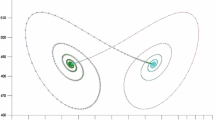Abstract
A successive continuation method for locating connecting orbits in parametrized systems of autonomous ODEs is considered. A local convergence analysis is presented and several illustrative numerical examples are given.
Similar content being viewed by others
References
N. Aubry, P. Holmes, J. L. Lumley and E. Stone, The dynamics of coherent structures in the wall region of a turbulent boundary layer, J. Fluid Mechanics 192 (1988) 115–173.
H. Beresticky and L. Nirenberg, Traveling fronts in cylinders, Ann. Inst. Henri Poincaré 9(5) (1992) 497–572.
W.-J. Beyn, The numerical computation of connecting orbits in dynamical systems, IMA J. Numer. Anal. 9 (1990) 379–405.
W.-J. Beyn, Global bifurcations and their numerical computation, in: Continuation and Bifurcations: Numerical Techniques and Applications, eds. D. Roose et al. (Kluwer, Dordrecht, The Netherlands, 1990) pp. 169–181.
D. L. Brown, M. G. Forest, B. J. Miller and N. A. Petersson, Computation and stability of fluxons in a singularly perturbed sine-Gordon equation, SIAM J. Appl. Math. 54(4) (1994) 1048–1066.
V. Canale, The computation of paths of homoclinic orbits, Ph.D. Thesis, Department of Computer Science, University of Toronto, Toronto, Canada (1994).
A. R. Champneys and Yu. A. Kuznetsov, Numerical detection and continuation of codimension-two homoclinic orbits, Int. J. Bif. and Chaos 4(4) (1994) 785–822.
A. R. Champneys, Yu. A. Kuznetsov and B. Sandstede, A numerical toolbox for homoclinic bifurcation analysis, Applied Nonlinear Mathematics Research Report No. 1.95, University of Bristol, Bristol, UK (1995).
L. O. Chua, C. W. Wu, A. Huang and C. Q. Zhong, A universal circuit for studying and generating chaos, Part I: Routes to chaos, IEEE Trans. on Circuits and Systems-I: Fundamental Theory and Applications 10(40) (1993) 732–744. Special Issue on Chaos in Electronic Circuits, Part A.
J. Dieudonné, Foundations of Modern Analysis (Academic Press, 1960).
B. Deng, Constructing homoclinic orbits and chaotic attractors, Int. J. Bif. and Chaos 4(4) (1994) 823–841.
B. Deng, private communication (1995).
E. J. Doedel and M. J. Friedman, Numerical computation of heteroclinic orbits, J. Comput. and Appl. Math. 26 (1989) 159–170.
E. J. Doedel, M. J. Friedman and J. Guckenheimer, On computing connecting orbits: general algorithm and application to the sine-Gordon and Hodgkin-Huxley equations, The IEICE Transactions on Fundamentals of Electronics, Communications and Computer Science 77(11) (1994). Special Section on Nonlinear Theory and Its Applications.
E. J. Doedel, M. J. Friedman and A. C. Monteiro, On locating connecting orbits, Appl. Math. and Comput. 65(1–3) (1994) 231–239.
E. J. Doedel, H. B. Keller and J. P. Kernévez, Numerical analysis and control of bifurcation problems, Part I: Bifurcation in finite dimensions, Int. J. Bif. and Chaos 1(3) (1991) 493–520; Part II: Bifurcation in infinite dimensions, Int. J. Bif. and Chaos 1(4) (1991) 745–772.
E. J. Doedel, X. J. Wang and T. F. Fairgrieve, AUTO 94: Software for continuation and bifurcation problems in ordinary differential equations, Applied Mathematics Report, California Institute of Technology (1994).
E. Freire, L. G. Franquelo and J. Aracil, Periodicity and chaos in an autonomous electronic circuit, IEEE Transactions on Circuits and Systems CAS 31(3) (1984) 237–247. 124 E. J. Doedel et al. / Successive continuation for locating connecting orbits
E. Freire, A. J. Rodríguez-Luis, E. Gamero and E. Ponce, A case study for homoclinic chaos in an autonomous electronic circuit, Physica D 62 (1993) 230–243.
M. J. Friedman, Numerical analysis and accurate computation of heteroclinic orbits in the case of center manifolds, J. Dynam. Diff. Eq. 5(1) (1993) 59–87.
M. J. Friedman and E. J. Doedel, Numerical computation and continuation of invariant manifolds connecting fixed points, SIAM J. Numer. Anal. 28(3) (1991) 789–808.
M. J. Friedman and E. J. Doedel, Computational methods for global analysis of homoclinic and heteroclinic orbits: a case study, J. Dynam. Diff. Eq. 5(1) (1993) 37–58.
G. H. Golub and C. F. Van Loan, Matrix Computations (Johns Hopkins Univ. Press, 1989).
P. Gray and S. K. Scott, Chemical Oscillations and Instabilities: Nonlinear Chemical Kinetics (Oxford, 1990).
H. B. Keller, Global homotopies and Newton's methods, in: Recent Advances in Numerical Analysis (Academic Press, 1978) pp. 73–94.
S. Lang, Introduction to Differential Manifolds (Interscience, New York, 1962).
M. Lentini and H. B. Keller, Boundary value problems over semi infinite intervals and their numerical solution, SIAM J. Numer. Anal. 17 (1980) 557–604.
B. A. Malomed and R. S. Tasgal, Vibration modes of a gap soliton in nonlinear optical medium, Phys. Rev. E 49(6) (1994) 5787–5796.
F. C. Moon, Chaotic Vibrations: An Introduction for Applied Scientists and Engineers (Wiley, New York, 1987).
J. Rinzel and G. B. Ermentrout, Analysis of neural excitability and oscillations, in: Methods in Neural Modeling: From Synapses to Networks, eds. C. Koch and I. Sedev (MIT Press, Cambridge, MA, 1989).
A. J. Rodríguez-Luis, E. Freire and E. Ponce, A method of homoclinic and heteroclinic continuation in two and three dimensions, in: Continuation and Bifurcations: Numerical Techniques and Applications, eds. D. Roose et al. (Kluwer, Dordrecht, The Netherlands, 1990) pp. 197–210.
B. Sandstede, Convergence estimates for the nunerical approximation of homoclinic solutions, Preprint No. 198, Weierstrass-Institut f #x00FC;r Angewandte Analysis und Stochastik, Berlin (1995).
S. Schecter, Numerical computation of saddle-node homoclinic bifurcation points, SIAM J. Numer. Anal. 30(4) (1993) 1155–1178.
Author information
Authors and Affiliations
Rights and permissions
About this article
Cite this article
Doedel, E.J., Friedman, M.J. & Kunin, B.I. Successive continuation for locating connecting orbits. Numerical Algorithms 14, 103–124 (1997). https://doi.org/10.1023/A:1019152611342
Issue Date:
DOI: https://doi.org/10.1023/A:1019152611342




